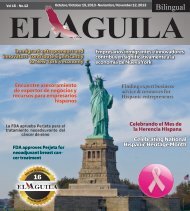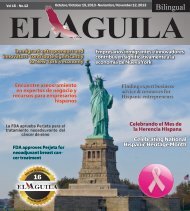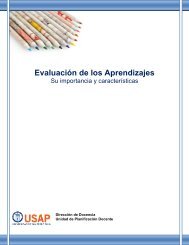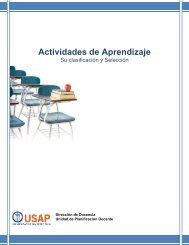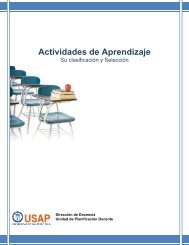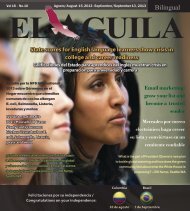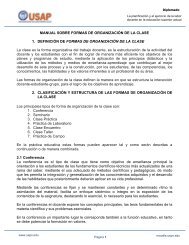AGUILA
You also want an ePaper? Increase the reach of your titles
YUMPU automatically turns print PDFs into web optimized ePapers that Google loves.
Medio Ambiente<br />
Environment<br />
There has been considerable talk of how dangerous synthetic sugar substitutes may be for our health, but little<br />
evidence of harm has actually come forth and their environmental impacts may be more reason for concern.<br />
Se ha hablado considerablemente del peligro de los sustitutos sintéticos del azúcar quizás por nuestra salud, pero<br />
se ha visto muy poca evidencia del daño y su impacto ambiental puede ser una mayor razón para preocuparse.<br />
-- Terri Oelrich, via e-mail<br />
La producción de azúcar de hecho ha tenido<br />
un enorme costo ambiental. “El azúcar<br />
ha tenido sin duda un gran impacto sobre<br />
el medio ambiente como cualquier otro producto<br />
agrícola”, reporta el Word Worldlife Fund (WWF<br />
por sus siglas en inglés), citando la pérdida de biodiversidad<br />
como consecuencia de la “conversion<br />
al por mayor del hábitat en las islas tropicales y zonas<br />
costeras” para producir azúcar. WWF agrega<br />
que el cultivo de azúcar también ha resultado en<br />
considerable erosión del suelo y degradación y el<br />
uso de grandes cantidades de químicos en todo el<br />
trópico y más allá.<br />
Algunos mercados de comidas naturales ahora<br />
tienen azúcar cosechada sosteniblemente que no<br />
encaja con este perfil, aunque la historia fea de la<br />
azúcar ha llevado a muchos consumidores conscientes<br />
de la ecología a saciar sus deseos de dulce<br />
en otros lugares. Afortunadamente existen varias<br />
opciones naturales y artificiales que son seguras<br />
para comer y relativamente benignas para el medio<br />
ambiente. Tal vez la selección mas popular es<br />
stevia, una hierba de Latino América cosechada<br />
sosteniblemente que es 30 veces más dulce que el<br />
azúcar de mesa pero sin calorías. Otra alternativa<br />
natural incluye el azúcar de palma de coco, sirope<br />
de malta de cebada, sirope de arroz integral, miel<br />
de agave, sirope de arce y miel cruda. Estas selecciones<br />
no pueden ahorrar calorías como stevia, pero<br />
endulzan sin culpabilidad ambiental.<br />
En cuanto a las alternativas para azúcar sintética,<br />
se ha hablado mucho de lo peligroso que pueden<br />
ser para nuestra salud, pero existe poca evidencia<br />
del daño que actualmente han causado y sus<br />
impactos ambientales pueden ser mas razón para<br />
preocuparse. Aspartame, por ejemplo, usado en<br />
Equal y también en refrescos de dieta, está hecho<br />
fermentando el maíz y la soya, los dos principales<br />
cultivos de ingeniería genética en los Estados Unidos.<br />
Los ambientalistas están preocupados que tales<br />
retoques de la naturaleza podrían tener resultados<br />
inesperados y potencialmente desastrosos<br />
en el futuro.Otra alternativa común del azúcar, sucralosa<br />
(nombre comercial Splenda) también tie-<br />
Querido Diálogo Ecológico:<br />
ne sus problemas. Un estudio publicado en 2013<br />
por investigadores de la University of North Carolina<br />
(UNC por sus siglas en inglés) encontró que<br />
la mayoría de Splenda utilizada en todo el mundo<br />
termina en la Corriente del Golfo, la corriente<br />
oceánica más rápida que comienza en el Golfo<br />
de México y desemboca en el Océano Atlántico y<br />
más allá en las aguas costeras de Europa y África.<br />
“La sucralosa no puede ser rota por la bacteria en<br />
el tracto digestivo humano”, reporta UNC. “Como<br />
resultado, el cuerpo absorbe poco o ninguna<br />
caloría y 90 porciento del compuesto químico deja<br />
el cuerpo mediante el excremento humano y entra<br />
en los sistemas de aguas negras”. Debido a que<br />
la mayoría de los sistemas de tratamiento de aguas<br />
no pueden romper la sucralosa, esta termina en los<br />
océanos, donde se desconocen los efectos a largo<br />
plazo.<br />
La sacarina (nombre comercial Sweet’N Low) tuvo<br />
una mala reputación en los 1970’s cuando ratas<br />
expuestas a grandes cantidades tuvieron cáncer de<br />
la vejiga, pero desde entonces ha sido reivindicada:<br />
La Administración de Alimentos y Medicamentos<br />
removió las etiquetas de advertencia en<br />
2000 y la Agencia de Protección Ambiental la removió<br />
de sus listas de componentes peligrosos y<br />
productos químicos comerciales en 2010. Sin embargo,<br />
la sacarina puede causar problemas para las<br />
mujeres embarazadas y lactantes quienes consumen<br />
grandes cantidades, y también recibe un veto<br />
como derivado del petróleo.<br />
CONTACTOS: WWF, www.wwf.org; “Fake<br />
sweetener Splenda fills our oceans, scientists<br />
find,” www.naturalnews.com/039156_splenda_<br />
ocean_pollution_environment.html, “The Sweet<br />
Side of Fair Trade,” Green America, www.greenamerica.org/livinggreen/SweetFairTrade.cfm<br />
.<br />
EarthTalk® es escrito y editado por Roddy<br />
Scheer y Doug Moss y es un nombre comercial<br />
registrado: E - The Environmental Magazine<br />
(www.emagazine.com). Envíe sus preguntas a:<br />
earthtalk@emagazine.com. Suscríbase: www.<br />
emagazine.com/subscribe. Edición de Prueba<br />
Gratuita: www.emagazine.com/trial.<br />
Credit: abbyladybug, courtesy Flickr<br />
EL <strong>AGUILA</strong> Octubre/October 15, 2013 -Noviembre/November 12 , 2013 6<br />
¿Estamos consciente de los daños que<br />
causan los diferentes endulzantes (artificiales<br />
o naturales) al medio ambiente?<br />
Dear EarthTalk: We are aware<br />
of the damage they cause different<br />
sweeteners (artificial or<br />
natural) the environment?<br />
-- Terri Oelrich, via e-mail<br />
The production of sugar has indeed taken a<br />
huge environmental toll. “Sugar has arguably<br />
had as great an impact on the environment<br />
as any other agricultural commodity,” reports<br />
the World Wildlife Fund (WWF), citing biodiversity<br />
loss as a result of the “wholesale conversion of<br />
habitat on tropical islands and on coastal areas” to<br />
grow sugar. WWF adds that the cultivation of sugar<br />
has also resulted in considerable soil erosion and<br />
degradation and the use of large amounts of chemicals<br />
across the tropics and beyond.<br />
Some natural food markets now carry sustainably<br />
harvested sugar that does not fit this profile, though<br />
sugar’s ugly history has led many eco-conscious<br />
consumers to look elsewhere to satiate their sweet<br />
teeth. Fortunately there are several natural and artificial<br />
options that are safe to eat and relatively benign<br />
for the environment. Perhaps the most popular<br />
choice is stevia, a sustainably harvested herb from<br />
Latin America that is 30 times sweeter than table<br />
sugar but without calories. Other natural alternatives<br />
include coconut palm sugar, barley malt syrup,<br />
brown rice syrup, agave nectar, maple syrup and<br />
raw honey. These choices may not save on calories<br />
like stevia, but they do sweeten without environmental<br />
guilt.<br />
As for synthetic sugar alternatives, there has been<br />
considerable talk of how dangerous they may be<br />
for our health, but little evidence of harm has actually<br />
come forth and their environmental impacts<br />
may be more reason for concern. Aspartame, for<br />
example, used in Equal and also in diet sodas, is<br />
made by fermenting corn and soy, the two biggest<br />
genetically engineered crops in the U.S. Environmentalists<br />
are concerned that such tinkering with<br />
nature could have unexpected and potentially di-<br />
sastrous results down the road.<br />
Another common sugar alternative, sucralose<br />
(trade name Splenda) has its issues, too. A study<br />
released in 2013 by researchers from the University<br />
of North Carolina (UNC) found that the majority<br />
of Splenda used around the world ends up<br />
in the Gulf Stream, the fast-moving ocean current<br />
that starts in the Gulf of Mexico and flows into the<br />
Atlantic Ocean and beyond into the coastal waters<br />
of Europe and Africa.<br />
“Sucralose cannot be effectively broken down by<br />
the bacteria in the human digestive tract,” reports<br />
UNC. “As a result, the body absorbs little or no calories<br />
and 90 percent of the chemical compound<br />
leaves the body through human waste and enters<br />
sewage systems.” Since this sucralose cannot be<br />
broken down by most water treatment systems, it<br />
ends up in the oceans, where the long-term effects<br />
remain unknown.<br />
Saccharin (trade name Sweet’N Low) got a bad<br />
rap in the 1970s when rats exposed to large amounts<br />
got bladder cancer, but it has since been vindicated:<br />
The Food & Drug Administration removed<br />
warning labels in 2000 and the Environmental<br />
Protection Agency removed it from its lists of<br />
hazardous constituents and commercial chemical<br />
products in 2010. Nonetheless, saccharin can cause<br />
problems for pregnant women and infants who<br />
consume large amounts, and also gets a veto as a<br />
petroleum derivative.<br />
CONTACTS: WWF, www.wwf.org; “Fake<br />
sweetener Splenda fills our oceans, scientists<br />
find,” www.naturalnews.com/039156_splenda_<br />
ocean_pollution_environment.html, “The Sweet<br />
Side of Fair Trade,” Green America, www.greenamerica.org/livinggreen/SweetFairTrade.cfm.<br />
EarthTalk® is written and edited by Roddy<br />
Scheer and Doug Moss and is a registered trademark<br />
of E - The Environmental Magazine<br />
(www.emagazine.com). Send questions to: earthtalk@emagazine.com.<br />
Subscribe: www.emagazine.com/subscribe.<br />
Free Trial Issue: www.<br />
emagazine.com/trial.



